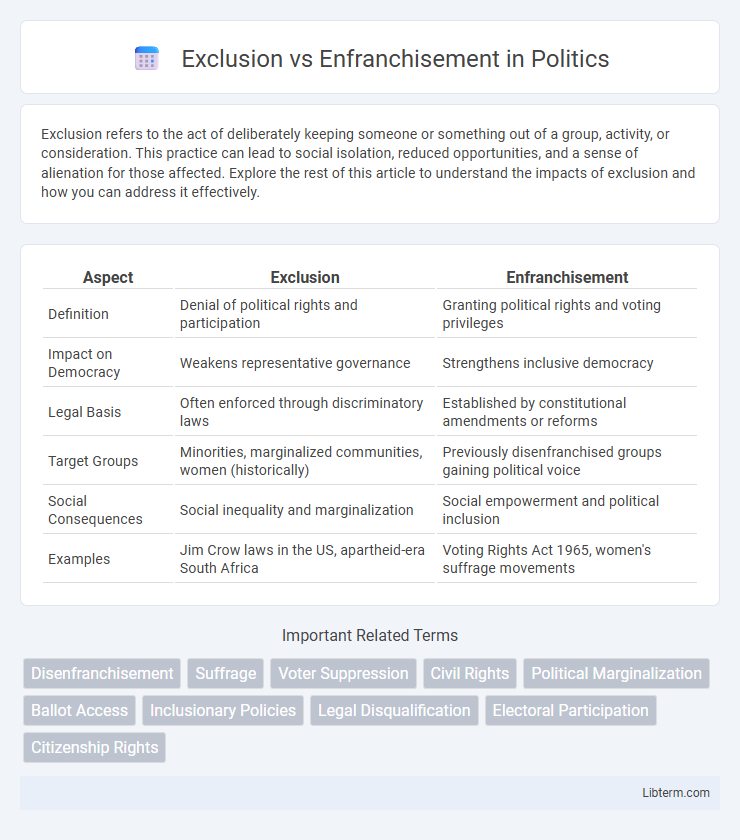Exclusion refers to the act of deliberately keeping someone or something out of a group, activity, or consideration. This practice can lead to social isolation, reduced opportunities, and a sense of alienation for those affected. Explore the rest of this article to understand the impacts of exclusion and how you can address it effectively.
Table of Comparison
| Aspect | Exclusion | Enfranchisement |
|---|---|---|
| Definition | Denial of political rights and participation | Granting political rights and voting privileges |
| Impact on Democracy | Weakens representative governance | Strengthens inclusive democracy |
| Legal Basis | Often enforced through discriminatory laws | Established by constitutional amendments or reforms |
| Target Groups | Minorities, marginalized communities, women (historically) | Previously disenfranchised groups gaining political voice |
| Social Consequences | Social inequality and marginalization | Social empowerment and political inclusion |
| Examples | Jim Crow laws in the US, apartheid-era South Africa | Voting Rights Act 1965, women's suffrage movements |
Defining Exclusion and Enfranchisement
Exclusion refers to the systematic denial of rights or privileges to individuals or groups, often based on factors like race, gender, or socioeconomic status, resulting in limited participation in political, social, or economic activities. Enfranchisement is the granting of voting rights and broader civic participation, enabling individuals to engage fully in democratic processes and decision-making. Understanding exclusion and enfranchisement is crucial to addressing inequalities and promoting inclusive governance.
Historical Contexts: From Margins to Mainstream
Exclusion and enfranchisement have shaped political and social landscapes from historical margins to mainstream societies, reflecting struggles for rights and recognition. In many historical contexts, groups such as women, racial minorities, and colonized peoples were systematically excluded from voting and civic participation, entrenching power imbalances. The gradual enfranchisement movements, including the suffrage campaigns and civil rights activism, marked pivotal shifts toward inclusive democracies that expanded political representation and social justice.
Causes and Mechanisms of Social Exclusion
Social exclusion arises from systemic barriers such as poverty, discrimination, and lack of access to education or employment, which limit individuals' participation in social, economic, and political life. Mechanisms of social exclusion include institutional biases, segregation, and social stigmatization that marginalize certain groups based on race, gender, ethnicity, or socioeconomic status. Enfranchisement counters exclusion by granting rights, access, and opportunities, promoting inclusion through legal reforms, social policies, and community empowerment initiatives.
Political Enfranchisement: Pathways to Inclusion
Political enfranchisement transforms marginalized groups into active participants within democratic systems by granting voting rights and fostering civic engagement. Inclusive policies and legal reforms dismantle barriers such as discriminatory laws and socioeconomic obstacles, enabling broader access to political representation and decision-making processes. Empowering disenfranchised populations through education and community mobilization strengthens democratic legitimacy and promotes social equity.
Exclusion vs Enfranchisement in Voting Rights
Exclusion in voting rights refers to the systematic denial of the right to vote based on race, gender, age, or socioeconomic status, historically disenfranchising marginalized groups such as African Americans, women, and indigenous populations. Enfranchisement marks the legal and social process by which previously excluded groups gain the right to vote, exemplified by landmark legislation like the 15th and 19th Amendments in the United States and the Voting Rights Act of 1965. The tension between exclusion and enfranchisement reflects ongoing struggles for equal political participation and highlights the importance of protecting voting rights to ensure democratic representation.
Economic Implications of Exclusionary Practices
Exclusionary practices restrict marginalized groups from accessing economic opportunities, leading to persistent income disparities and reduced overall productivity. Enfranchisement enables broader participation in economic activities, fostering inclusive growth, higher employment rates, and increased innovation. The economic implications of exclusion include diminished consumer bases and slower economic development due to underutilized human capital.
Enfranchisement and Social Mobility
Enfranchisement, the process of granting voting rights and civic participation, plays a crucial role in enhancing social mobility by empowering marginalized groups to influence policies affecting education, employment, and economic opportunities. Access to political rights enables individuals to advocate for systemic changes that reduce inequality and create pathways for upward social movement. Historical data shows that expanded enfranchisement correlates with improved social mobility indicators, including higher income levels and better access to public services.
Legal Frameworks: Protecting Inclusion
Legal frameworks addressing exclusion and enfranchisement center on ensuring equal voting rights and preventing discriminatory practices. Landmark legislation such as the Voting Rights Act of 1965 in the United States and the Representation of the People Act 1918 in the UK exemplify efforts to protect marginalized groups and expand suffrage. These laws establish regulatory mechanisms to dismantle barriers like literacy tests, property requirements, and racial segregation, promoting inclusive democratic participation.
Case Studies: Lessons from Global Movements
Case studies of global movements reveal that exclusion often fuels social unrest and impedes democratic progress, as seen in South Africa's apartheid regime and India's colonial struggle for independence. Enfranchisement initiatives, such as the U.S. Civil Rights Movement and the extension of voting rights to women worldwide, highlight the transformative impact of inclusive policies on political stability and social equity. These examples demonstrate that expanding rights and participation strengthens democratic institutions and promotes sustainable development.
Toward an Inclusive Future: Policy Recommendations
Policy recommendations for advancing enfranchisement emphasize removing systemic barriers such as voter ID laws and disenfranchisement of formerly incarcerated individuals to promote equal voting rights. Implementing automatic voter registration and expanding early voting options increases accessibility and participation across marginalized communities. Investing in civic education and community engagement initiatives supports sustained inclusion and empowers historically excluded populations to shape democratic processes.
Exclusion Infographic

 libterm.com
libterm.com